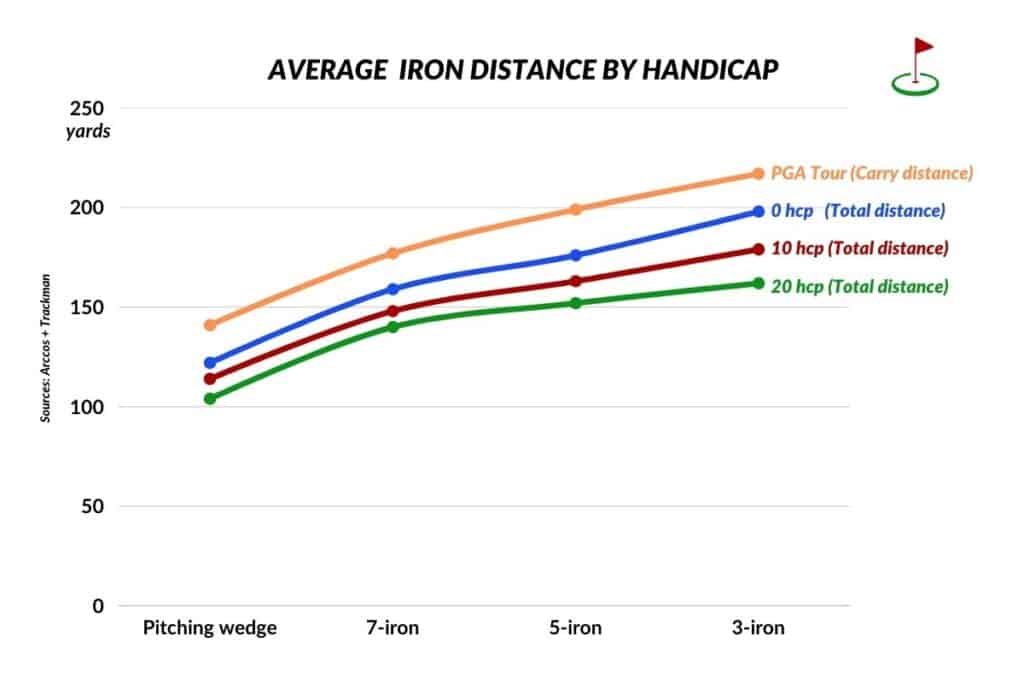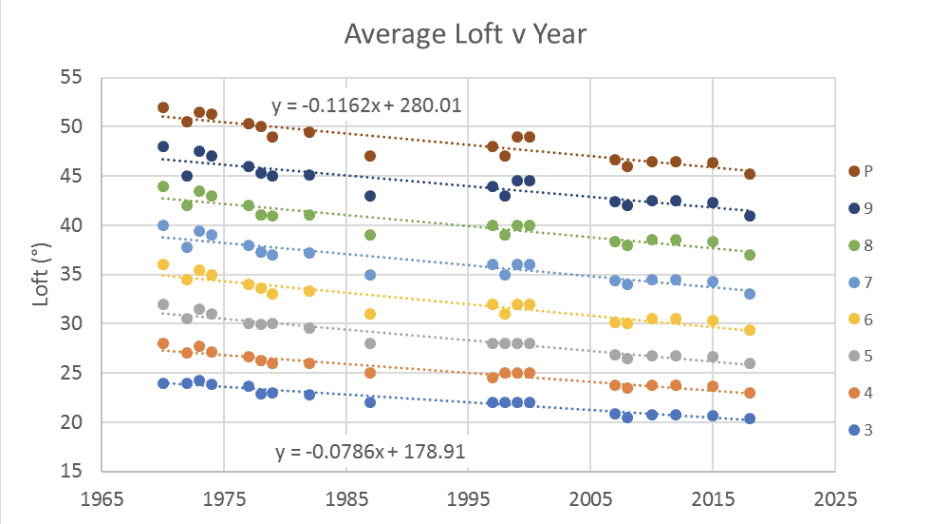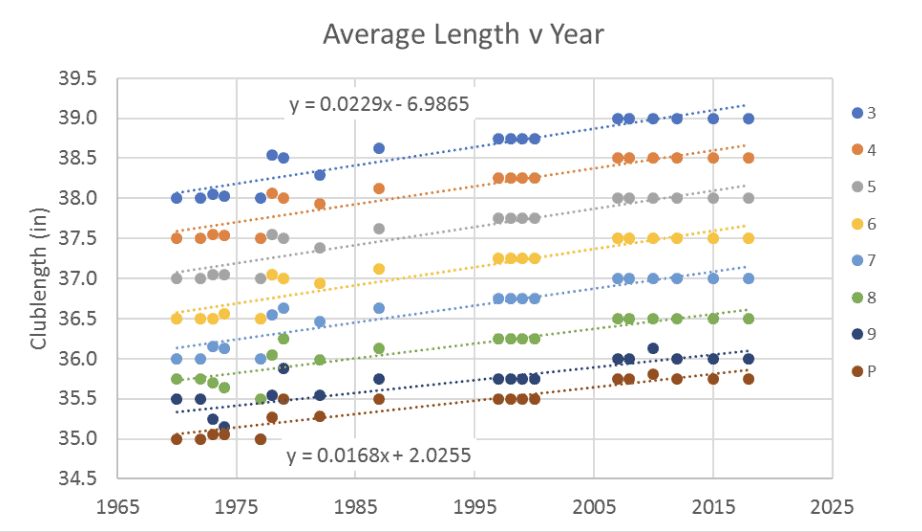How Far Should I Hit My Irons? By Handicap, Age & Swingspeed

When it comes to discussions of distance in golf the focus is typically on the longest clubs in the bag but it is clearly just as important that amateurs have a clear idea of how far they hit their irons?
And as with everything in golf what most golfers want to know is how the distance they hit their irons compares with the ‘average’ golfer and their peers.
In total the average golfer with a handicap of 14.4 and swingspeed of 93.4 mph hits a 3-iron 172 yards, a 5-iron 159 yards, a 7-iron 145 yards, a 9-iron 121 yards and a pitching wedge 110 yards. Past the age of 30 the average golfer loses iron distance consistently until 60 after which much larger drops start to occur.
Simply looking at how far you hit your irons from one perspective is however not as helpful as it could be as different golfers clearly can be of many different standards and also hit their irons in different ways for different approach shots.
And both of these things have an impact on distance.
So in this article we take a detailed look at the question of how far you should hit your irons by analysing the topic by handicap, age and swingspeed to give amateurs as accurate an idea as possible of how their iron distances match up against others.
We also explain how iron distances have been affected by the progressive changes in iron lofts and iron lengths by club manufacturers over the years and why those changes make it so difficult to compare iron yardages between amateur golfers!
[Top tip: Improving your fitness and swing speed will make a huge difference to how far you hit the ball and has the potential to add 20 to 30 yards to drives and an extra club throughout the bag. If you want to know how you can achieve this check out two of the best ‘golf training’ programs that can get you there:
- The Stack System
- Fit for Golf (Use discount code GOLFINGFOCUS20 for 20% off annual subscriptions!)
Average Iron Distances by Handicap (including Chart)
The most common way amateur golfers compare themselves to each other is obviously by handicap.
So when it comes to measuring up against other players regarding the question of how far you hit your irons it makes sense to analyse average iron distances by handicap.
But whatever your handicap ask yourself how many of us simply start with the classic assumption that you hit your 7-iron 150 yards and that there’s then a 10 yard gap between irons from there across the rest of your iron set.
A quick look at the internet and it won’t take you long to find a bunch of articles which give you that impression but is 150 yards really how far you should hit a 7-iron?
On average 10 handicap golfers hit a 7-iron a total distance of 148 yards (135 meters) while 20 handicappers average 140 yards (128m) according to Arccos’ analysis of millions of amateurs shots. Scratch handicap players hit a 7-iron 159 yards (145m) on average compared to 177 yards (162m) for the average PGA Tour pro.
Arccos is golf’s first artificial intelligence (AI) shot tracking platform and is therefore able to take a detailed look at the millions of golf shots played by their users across multiple countries to come up with a much more accurate picture of how far amateurs truly hit their irons.
And by measuring ‘smart distances’ systems such as these remove abnormal short duff shots or long downhill/downwind ones to give as an accurate average as possible of how far their users hit a well-struck shot with each iron.
When it comes to the 7-iron ‘smart’ distances Arccos has recorded we can therefore immediately see that it is only once you get to the games of single-figured golfers, who make up less than 1/3 of the golfers in the US, that the average total distance starts to reach the much accepted ‘standard’ 150-yard mark.
For the vast majority of amateurs however the reality is different and it is vital for all golfers who are serious about getting better that they have a clear view of how far they actually hit their irons rather than making club selections based on untested assumptions.
When it comes to the rest of the irons in the bag Arccos has only published data on how far amateur golfers of scratch, 10 and 20 handicaps hit their 3-iron, 5-iron and pitching wedge on average, in addition to the 7-iron yardages detailed above and these total iron distances are shown in the table and chart below.
| IRON CLUB | 0 HCP | 10 HCP | 20 HCP |
| 3-iron (total yards) | 198 | 179 | 162 |
| 5-iron (total yards) | 176 | 163 | 152 |
| 7-iron (total yards) | 159 | 148 | 140 |
| PW (total yards) | 122 | 114 | 104 |

I for one was a bit surprised by these yardages but when you think about how difficult it is to hit longer irons in particular these numbers should probably not really come as much of a shock.
There is one key factor which all amateurs should also bear in mind though when it comes to comparing how far they hit their irons with other golfers and that is how much the standard lofts and lengths of irons have changed over the years.
The following graphs, published in the USGA’s Annual Distance report, detail that on average iron club lofts have decreased by 4º since 1980 at the same time as the length of irons has increased.


And what this translates to in the real world for example is that an iron which was maybe labelled a 7-iron in an older set of clubs is now stamped as an 8-iron in the latest set of irons.
Given amateur golfers across the world play with such a variety of irons of different ages and brands this clearly highlights the difficulty of comparing how far different players hit their irons with each other.
So the next time you ask your playing partner what iron they hit for that last shot to get an idea for your own shot bear in mind that their set of irons may be very different to yours depending on who made them and when!
[Note – If you are interested in Arccos – Golf’s first artificial intelligence shot tracking platform – and getting an exact idea of how far you hit the ball so you choose the right club every time click here to get 15% off when you use our discount code – GOLFINGFOCUS15. Recognised by Golf Digest Editor’s awards 5 years running Arccos’ members improve by an average of 5 strokes in their first year of membership!]
Average Golf Iron Distance by Age
When it comes to how far you should hit your irons age clearly is also a key factor.
It is no great secret that golfers lose distance as they age but does the average golf iron distance gradually decline with age or drop off a cliff once players reach a certain stage in their golfing life?
As a general rule the average golfer will lose approximately 4 yards of the total distance they hit a 7-iron every 10 years after they reach the age of 30 according to golf’s first artificial intelligence (AI) shot tracking platform, Arccos. After 60 years of age iron distances then however drop off more severely.
While comprehensive iron distance data is readily available for the pros along with any other number of stats you care to think of, detailed and tested numbers on how far different age groups hit their irons are sadly not so readily available.
Thankfully in the modern era however shot-tracking systems such as Arccos and Shotscope have enabled the on-course capture of millions of shots by amateurs of all ages and standards which allows us to be much more accurate with our estimates as to how far different age groups of golfers hit their irons.
Unfortunately though nobody currently makes a complete data set for iron distances available to enable us to zero in on precisely how many yards amateurs can expect to lose in the distance they hit their irons as they get older.
But Arccos and Shoptscore have both published data on how far average golfers hit their driver broken down by age based on their analysis of millions of their users’ golf shots and this has allowed us to make the following estimates for the total average distance different age groups hit their irons:
| IRON CLUB | 20 – 29 YEARS | 30 – 39 YEARS | 40 – 49 YEARS | 50 – 59 YEARS | 60 – 69 YEARS | 70 YEARS |
| 5-iron (total yards) | 168 | 165 | 160 | 153 | 145 | 133 |
| 6-iron (total yards) | 161 | 157 | 152 | 146 | 138 | 127 |
| 7-iron (total yards) | 154 | 149 | 145 | 141 | 130 | 117 |
| 8-iron (total yards) | 142 | 139 | 134 | 129 | 122 | 112 |
| 9-iron (total yards) | 130 | 128 | 124 | 119 | 112 | 101 |
| PW (total yards) | 119 | 117 | 113 | 107 | 101 | 91 |
These stats are obviously clear on the following facts:
- After 30 the average golfer’s longest hitting days are behind them, and
- After 60 years of age the most severe distance drop-offs start to happen.
It is not all bad news however for golfers as they get older.
The stats also show that there is a clear link between increased age and accuracy off the tee and that until you hit 60 your approach shots will actually improve over time.
And although all the stats inevitably show senior golfers over 60 experiencing the biggest loses across all areas of the game it can surely still be of comfort that by that stage we hopefully have more leisure time to enjoy this great game more than we are able to before.
At the very least also being aware of when to be on the lookout for the ages when distance becomes harder to maintain can help you to consider when it may be time to take advantage of all that golf tech out there that is providing ever-increasing options to help golfers maintain distance.
How Far Should You Hit Your Irons Based on Swingspeed?
In days gone by your average golfer probably would not have even heard of the term ‘swingspeed’ never much considered it as a category for how to measure how far hit their irons compared to other players.
In modern golf however the topic of swingspeed has become a hugely important one as golf tech products such as Trackman and Shotlink have enabled golfers to understand its importance in relation to how far they hit the ball.
Once again when it comes to seeing how far golfers hit their irons broken down by swingspeed it is of course much harder to pull together stats for average amateur golfers by comparison to the pros who all carry their own individual launch monitors around with them wherever they go.
Based on the swingspeeds and yardages hit by the pros however experts in swing speed training, including PGA pro and GolfWRX senior writer Jaacob Bowden, have been able to apply some clever algebra to come up with estimates for how far you should hit your irons based on your swingspeed.
These estimates of ‘carry’ distances are included in the table below together with relevant benchmark comparisons with the pros.
| SWINGSPEED | 3-IRON | 4-IRON | 5-IRON | 6-IRON | 7-IRON | 8-IRON | 9-IRON | PW |
| 60 mph | 114 | 109 | 104 | 98 | 92 | 86 | 79 | 73 |
| 70 mph | 133 | 127 | 121 | 114 | 108 | 100 | 93 | 85 |
| 80 mph | 151 | 145 | 139 | 131 | 123 | 114 | 106 | 97 |
| 90 mph | 170 | 163 | 156 | 147 | 138 | 129 | 119 | 109 |
| 94 mph (LPGA Tour Avg.) | – | 169 | 161 | 152 | 141 | 130 | 119 | 107 |
| 100 mph | 189 | 181 | 173 | 163 | 154 | 143 | 132 | 121 |
| 106 mph (Champions Tour Avg.) | 201 | 192 | 184 | 173 | 163 | 151 | 140 | 129 |
| 110 mph | 208 | 199 | 191 | 180 | 169 | 157 | 145 | 134 |
| 114 mph (PGA Tour Avg.) | 217 | 208 | 199 | 188 | 177 | 164 | 153 | 141 |
| 120 mph | 227 | 218 | 208 | 196 | 184 | 171 | 159 | 146 |
| 130 mph | 246 | 236 | 225 | 212 | 200 | 186 | 172 | 158 |
| 132.2 mph (Bryson DeChambeau) | – | 255 | 235 | 220 | 205 | 190 | 175 | 160 |
| 141 mph (Long Drive Final Avg.) | 265 | 254 | 243 | 229 | 215 | 200 | 185 | 170 |
From these numbers we can clearly see the direct link between increased swingspeed and increased distance.
But if we then look at these numbers in conjunction with the average distances by handicap we analysed earlier we can also conclude that one of the reasons lower handicappers are hitting the ball further than higher handicappers is because they have a higher swingspeed.
As a result anyone hoping to hit the ball further has an increased incentive to work on their swingspeed.
Not only will it likely result in them hitting their irons further but will, according to the stats at least, more than likely result in them lowering their scores and handicap at the same time.
It’s not hard to see therefore why the metric of swingspeed is getting ever increasing focus in the modern game!
Before you go …
When it comes to talking distance in golf and how far you hit your irons the discussion is clearly more complex than it is compared to the question of how far you hit the longer clubs in your bag.
And that is for the simple reason that your irons are going to be used for a far greater variety of shots and as a result you will often be required to hit the same iron different distances over the course of the same round and indeed have a choice between more than one iron for the same shot.
So read our next article to find out how far you should hit the biggest club in the bag when there are no such restrictions and it’s almost always the case of just getting up on the tee and hitting the ball as far as you can!
How Far Should You Hit a Driver? FULL GUIDE By Age, Handicap etc.
[Note – Just so you know, and we are upfront as an affiliate program participant, Golfing Focus, at no cost to you, earns from qualifying purchases made through links on this page.]
Other top articles related to this topic:
- How Far Should You Hit a Driver? FULL GUIDE By Age, Handicap etc.
- How Far Does a 3 Wood vs 5 Wood Go? Tee and Approach Shots!
- How Far Should I Hit My Hybrids? 2 vs 3 vs 4 Hybrid Distances
- Hybrids vs. Fairway Woods – FULL Distance and Comparison Guide
- How Far Should I Hit My Irons? By Handicap, Age & Swingspeed
- How Far Should You Hit Your Wedges? Be Sure to Fill the Gaps!
- Why Don’t Your Drives Go Far? Slow and Steady Loses the Race
- How Far Should Your Driver Swingspeed Go? 60 to 120 mph Guide
- Average Driver Swingspeeds? COMPLETE GUIDE by Age, Handicap etc.
- Ideal Spin Rate and Launch Angle for Driver? That’s Personal!
- How Far Should Your Ball Speed Go? 100mph All the Way to 210mph!
- The PGA Tour’s Rising Driver Ball Speeds Mean One Thing – $$
- What Should Your Driver Attack Angle Be? Try Not to Be Negative
- How Much Does Driver Loft Affect Distance? Loft is Dynamic Too!
- 10 Ways to Get More Distance off The Tee With & Without Speed!
- What Determines Driver Distance? Skill Triumphs Over All!
- Are Driving Range Distances Accurate? Golf Balls are a Problem
- Do All Golf Balls Go the Same Distance? Physics First
- What Affects Golf Ball Distance? Beware ALL the Uncontrollables!
- Do Certain Golf Balls Go Further? Brand and Cost Considerations
- Do Distance Balls Go Further? Marketing Matters
RECENT ARTICLES
LEGAL INFORMATION
This site is owned and operated by Golfing Focus Limited, a private limited company whose registered office is in London, UK. Golfing Focus Limited is a participant in the Amazon Services LLC Associates Program, an affiliate advertising program designed to provide a means for sites to earn advertising fees (at no cost to you) by linking to Amazon.com. Golfing Focus Limited also participates in other affiliate programs with the eBay Partner Network, FlexOffers, CJ.com, Svorn and other sites and is compensated for referring traffic and business to these companies (again at no cost to you).
Our Socials






Leave a Reply